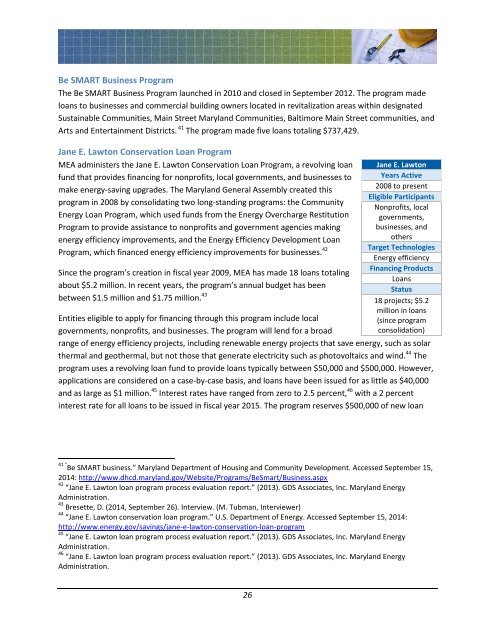bg4kk_f
bg4kk_f
bg4kk_f
You also want an ePaper? Increase the reach of your titles
YUMPU automatically turns print PDFs into web optimized ePapers that Google loves.
Be SMART Business Program<br />
The Be SMART Business Program launched in 2010 and closed in September 2012. The program made<br />
loans to businesses and commercial building owners located in revitalization areas within designated<br />
Sustainable Communities, Main Street Maryland Communities, Baltimore Main Street communities, and<br />
Arts and Entertainment Districts. 41 The program made five loans totaling $737,429.<br />
Jane E. Lawton Conservation Loan Program<br />
MEA administers the Jane E. Lawton Conservation Loan Program, a revolving loan<br />
fund that provides financing for nonprofits, local governments, and businesses to<br />
make energy-saving upgrades. The Maryland General Assembly created this<br />
program in 2008 by consolidating two long-standing programs: the Community<br />
Energy Loan Program, which used funds from the Energy Overcharge Restitution<br />
Program to provide assistance to nonprofits and government agencies making<br />
energy efficiency improvements, and the Energy Efficiency Development Loan<br />
Program, which financed energy efficiency improvements for businesses. 42<br />
Since the program’s creation in fiscal year 2009, MEA has made 18 loans totaling<br />
about $5.2 million. In recent years, the program’s annual budget has been<br />
between $1.5 million and $1.75 million. 43<br />
Entities eligible to apply for financing through this program include local<br />
governments, nonprofits, and businesses. The program will lend for a broad<br />
Jane E. Lawton<br />
Years Active<br />
2008 to present<br />
Eligible Participants<br />
Nonprofits, local<br />
governments,<br />
businesses, and<br />
others<br />
Target Technologies<br />
Energy efficiency<br />
Financing Products<br />
Loans<br />
Status<br />
18 projects; $5.2<br />
million in loans<br />
(since program<br />
consolidation)<br />
range of energy efficiency projects, including renewable energy projects that save energy, such as solar<br />
thermal and geothermal, but not those that generate electricity such as photovoltaics and wind. 44 The<br />
program uses a revolving loan fund to provide loans typically between $50,000 and $500,000. However,<br />
applications are considered on a case-by-case basis, and loans have been issued for as little as $40,000<br />
and as large as $1 million. 45 Interest rates have ranged from zero to 2.5 percent, 46 with a 2 percent<br />
interest rate for all loans to be issued in fiscal year 2015. The program reserves $500,000 of new loan<br />
41 “ Be SMART business.” Maryland Department of Housing and Community Development. Accessed September 15,<br />
2014: http://www.dhcd.maryland.gov/Website/Programs/BeSmart/Business.aspx<br />
42 “Jane E. Lawton loan program process evaluation report.” (2013). GDS Associates, Inc. Maryland Energy<br />
Administration.<br />
43 Bresette, D. (2014, September 26). Interview. (M. Tubman, Interviewer)<br />
44 “Jane E. Lawton conservation loan program.” U.S. Department of Energy. Accessed September 15, 2014:<br />
http://www.energy.gov/savings/jane-e-lawton-conservation-loan-program<br />
45 “Jane E. Lawton loan program process evaluation report.” (2013). GDS Associates, Inc. Maryland Energy<br />
Administration.<br />
46 “Jane E. Lawton loan program process evaluation report.” (2013). GDS Associates, Inc. Maryland Energy<br />
Administration.<br />
26


